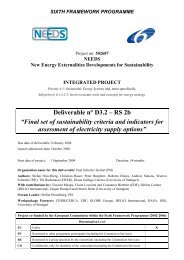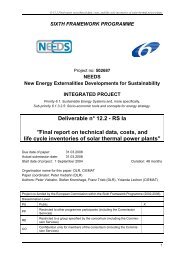Generation, of the energy carrier HYDROGEN In context ... - needs
Generation, of the energy carrier HYDROGEN In context ... - needs
Generation, of the energy carrier HYDROGEN In context ... - needs
You also want an ePaper? Increase the reach of your titles
YUMPU automatically turns print PDFs into web optimized ePapers that Google loves.
NyOrka Page 41 12/18/2008example <strong>of</strong> <strong>the</strong> trends but comments have been sought from developmental experts inorder to ground <strong>the</strong> realistic possibilities.This is <strong>the</strong> essence <strong>of</strong> <strong>the</strong> hydrogen handling chain; it is likely to be produced locallyfrom various sources, transported minimally unless it is generated as a by-product inindustry or produced centrally from gas or o<strong>the</strong>r carbon sources where <strong>the</strong> carbon dioxidecan be sequestrated as well. All extra handling poses extra costs because <strong>of</strong> <strong>the</strong> low<strong>energy</strong> density pr volume hydrogen. Large electrolytic centers will <strong>the</strong>refore beconnected to nuclear power stations and gasification, but smaller units, even local (home,<strong>of</strong>fice buildings, and community centers) power stations may be coupled to <strong>of</strong>f gridrenewable <strong>energy</strong> conversion equipment.As <strong>of</strong> yet, <strong>the</strong> hydrogen technology is in rapid development and <strong>the</strong>refore investments inlarge systems has not occurred; investors are waiting for more mature components. Pricefor petrol and decreased cost <strong>of</strong> an entire new infrastructure must give added value to <strong>the</strong>investors and <strong>the</strong> public before major changes will occur. The bio-fuel chain still has astronger stand on <strong>the</strong> world market as a newcomer in <strong>the</strong> environmental technologysector.Usually electricity is <strong>the</strong> only source <strong>of</strong> <strong>energy</strong> used in electrolysis. But <strong>the</strong> process isexo<strong>the</strong>rmic. It has been shown that <strong>the</strong> electrical <strong>energy</strong> can at least partially be replacedby heat. 52 Research is ongoing on high heat electrolysis, but when electrolysis is carriedout in temperatures above 700°C 10 – 20% <strong>of</strong> <strong>the</strong> electricity can be saved. Currently <strong>the</strong>cost and efficiency <strong>of</strong> electrolysis is not competitive to using steam reforming fromcarbon containing fuel.A reversible fuel cell /electrolyser has been demonstrated as an experimental unit.6 Specification <strong>of</strong> future technology configurationsTable 17 Hydrogen production technology datasheet: Electrolysis 53ELECTROLYSIS (30 BAR OUT) 2020 UnitSpecific hydrogen capacity (out) 2.500 kW(H 2 )Specific investment cost 500 €/kWTotal investment 1.250.000 €Annual operating hours 8.000 h/aLifetime 20 aAnnual hydrogen production 20.000.000 kWh(H 2 )/aOperation and Maintenance 1,5 % <strong>of</strong> investmentAnnual Operation and maintenance 100.000 €/aAnnuity 127.315 €/aTotal annual cost 146.065 €/aEfficiency (electricity-hydrogen) 70 %<strong>In</strong>put electricity 1,4286kWh(El.)/kWh(H2)Output hydrogen 1 kWh52Mansilla1 Christine, Jon Sigurvinsson1, André Bontemps, Alain Maréchal, François Werk<strong>of</strong>f: Heat management forhydrogen production by high temperature steam electrolysis, CEA, 200553 HySociety, 2003, Basic table <strong>of</strong> <strong>carrier</strong>s and barriers, edited and updated by FhG-ISI, 2005 and Icelandic NewEnergy 2006







